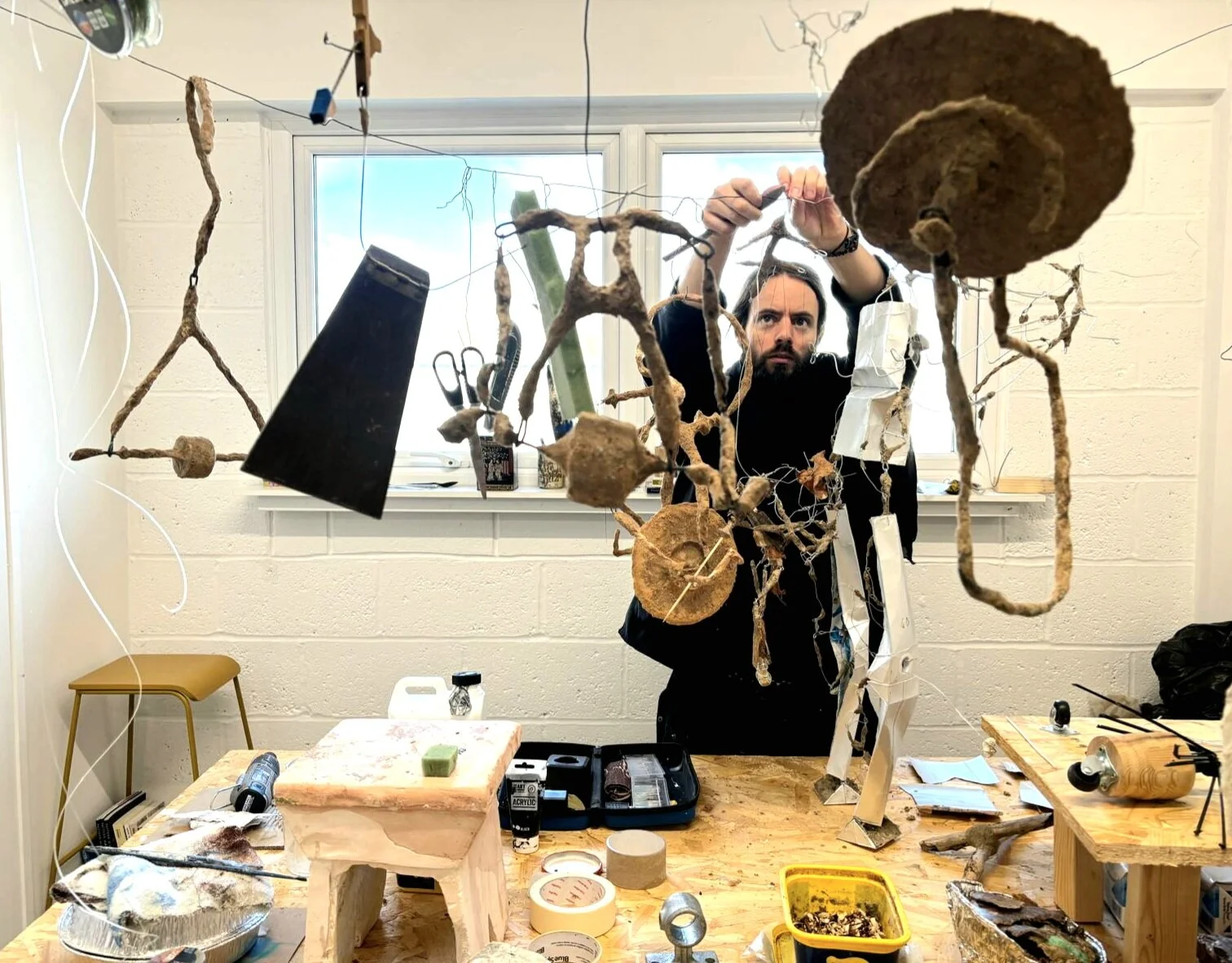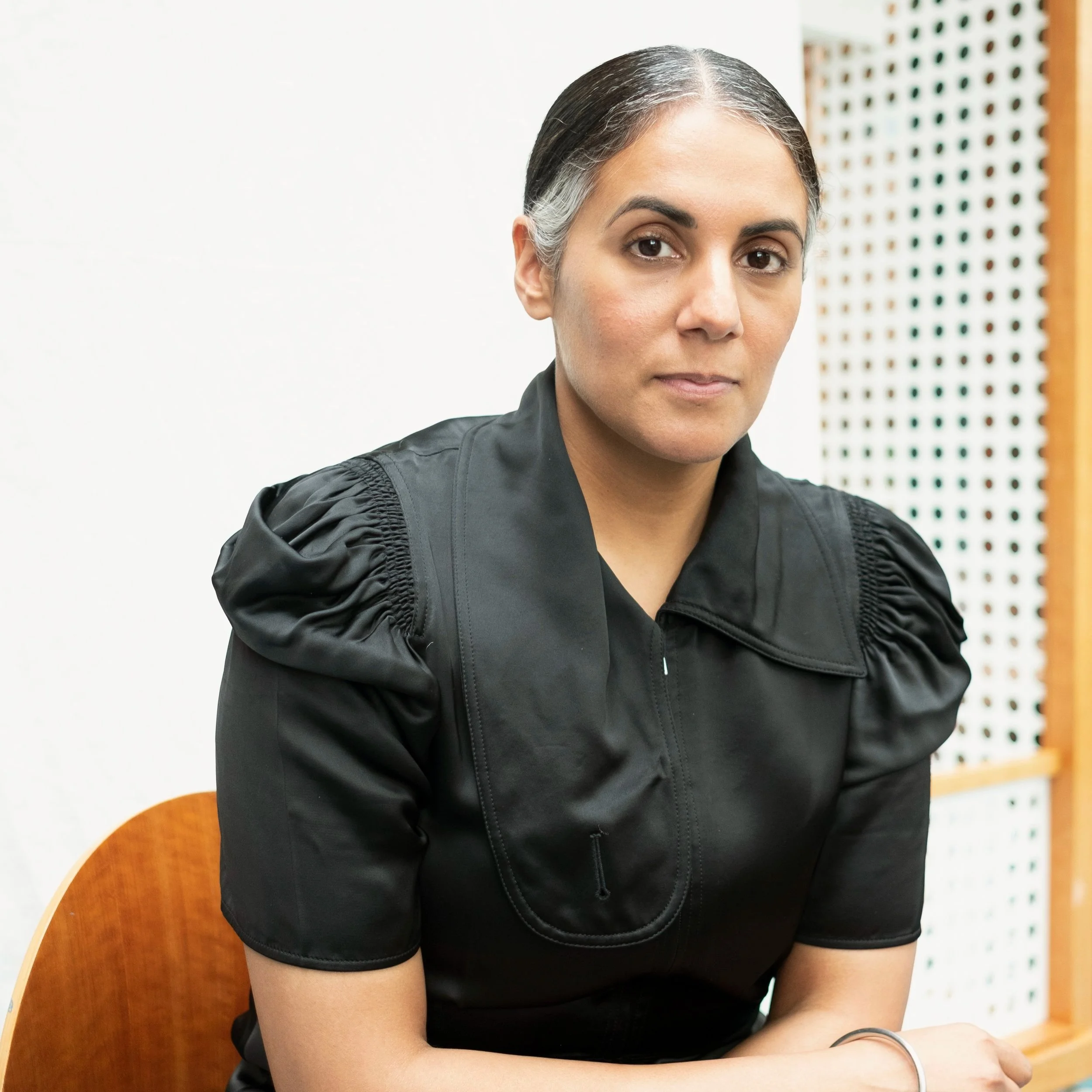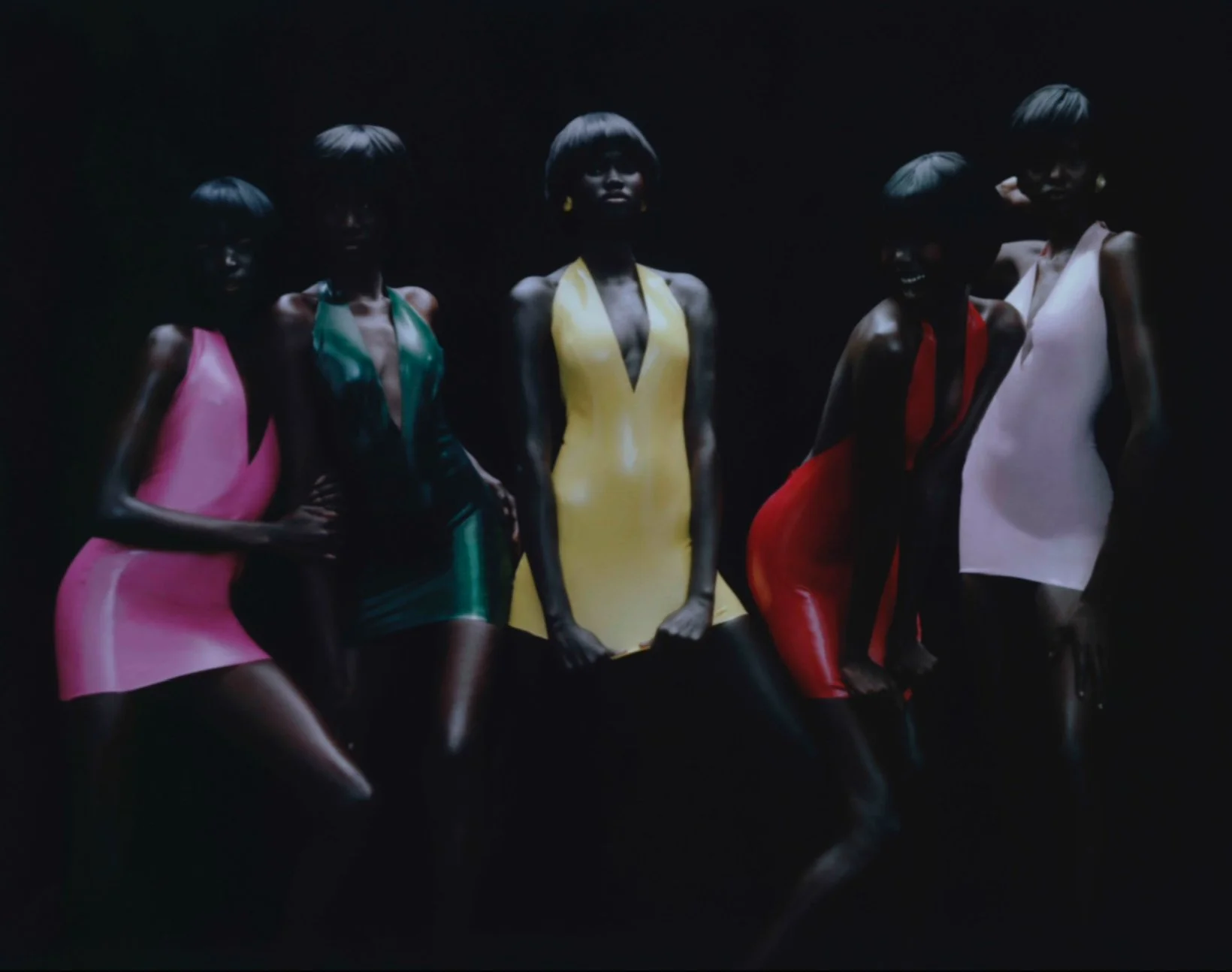In conversation with Daria Blum
“Even before I started performing within my own work (first to camera and later live) I was approaching most mediums with rhythm, musicality, and choreography in mind.”
- Daria Blum

Daria Blum. Image credit Shaun James Cox
Multidisciplinary artist Daria Blum graduated from the RA Schools in 2023, and in September that year won the inaugural Claridge’s Royal Academy Schools Art Prize – a £30,000 award selected by judges Yinka Shonibare CBE, RA and Eva Rothschild RA. The award was presented by performance artist Marina Abramović and introduced by actor, author and co-host of Talk Art Russell Tovey at the iconic Claridge’s, bringing to life a three-year long partnership to showcase standout art.
The result of this is now on show for the public to enjoy, with Daria Blum’s exhibition Drip Drip Point Warp Spin Buckle Rot at Claridge’s ArtSpace. The show centres around a three-channel video work which follows Blum’s fictional character as she walks through deserted rooms and corridors of a disused 1970’s office building. The protagonist comes across a cachet of materials which she reenacts as an act of reclamation: black and white portraits of Blum’s late grandmother, the Ukrainian ballerina and choreographer Daria Nyzankiwska, archival recordings of dance rehearsals, and footage of a 2022 performance by Blum herself. Through a series of live performances, Blum further inhabits a live character who disrupts and criticizes, pointing fingers at the bodies on-screen and the voices offstage.
It’s intriguing; it’s engaging. It’s sometimes unnerving. It’s something you just have to go and experience for yourselves. We were lucky enough to get the opportunity to dive a little deeper with the artist herself about her journey, her practice, and this extraordinary exhibition.
How did you begin your journey into art? Was it a creative environment where you grew up in Lucerne?
As children, my brother and I were always encouraged to draw. Our mother would hang giant sheets of paper on the walls of our bedrooms on which we could scribble. I also had a teacher in grades 1 – 3 who took our class to see Giacometti and Picasso exhibitions and organised extracurricular painting classes. I took weekly dance lessons at my mother’s ballet school from the age of three, and performed on stage in the annual recitals.
What was it about the London art scene and art colleges that ultimately made you want to study here?
Before moving here I’d never imagined myself living in London — when I’d visited the city in the past, I hadn’t really connected with it. But it seemed like London universities offered a really exciting programme. I applied to several BA Fine Art courses and ended up at Central Saint Martins. When I first moved to the city, I felt very energised by the competitive and fast pace of London life. Now that I’m used to it, it can sometimes be too much.
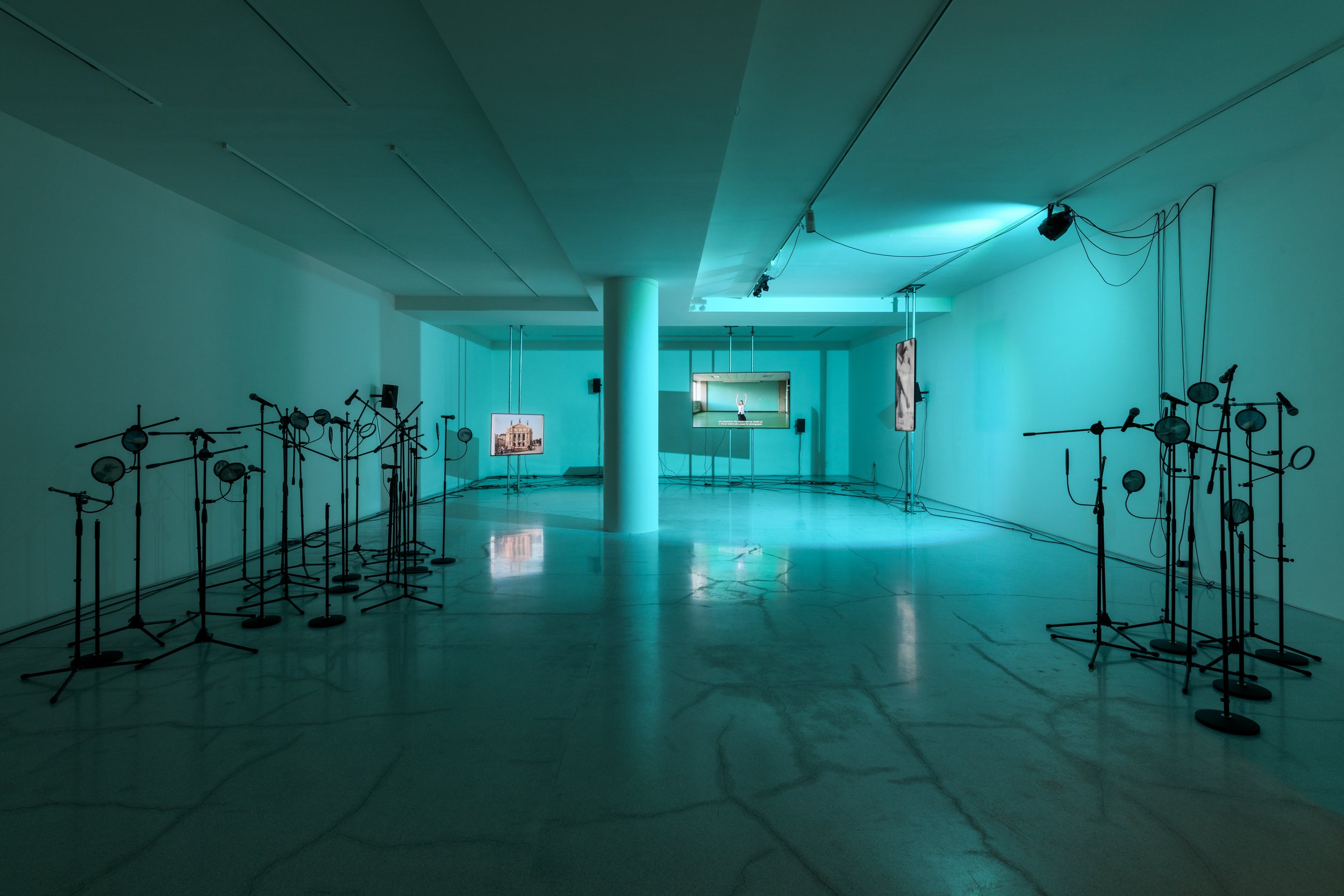
Drip Drip Point War Spin Buckle Rot, Daria Blum. Image credit Julian Blum.
Your work is inherently performative, comprised of both music and dance, which also comes from training in ballet from an early age. Has this always been a core part of expression for you as an artist?
Yes, I think so. Even before I started performing within my own work (first to camera and later live) I was approaching most mediums with rhythm, musicality, and choreography in mind. I always think about the way in which objects enter and exit a space, and the time-based nature of experiencing still works of art.
Now we often see you ‘multiplying’ yourself and interacting with those ‘selves’ – using your body and your voice alongside site-specific architecture.
This came quite naturally out of a desire to externalise an inner monologue, specifically a conversation among multiple parts, in order to better portray conflicting viewpoints. The idea of how choreography travels is interesting, as is the topic of its colonial tropes.

Daria Blum. Image credit Shaun James Cox.
How does your work express that, also bringing into play the element of your own mapping of a family tree?
During a recent residency in France, I came across archival images and newspaper clippings about performers, dancers, or ballet masters—names or faces I recognized from my mother’s stories of her time as a dancer. I began to map out a family tree through notes, photographs and conversations with her, and was able to connect via various dance figures to her mother Daria Nyzankiwska, who was a ballerina at Ukraine’s Lviv Opera House. In the video there is this attempt to ‘embody’ the grandmother I never knew, synchronising my own movements with the still poses of her in black and white portraits.
Shown in the video piece is my mother’s ballet school in Lucerne, Switzerland. To me, these now demolished dance studios act as a gateway to reflections on classical dance as an ‘archeological site’, where history, knowledge, and new interpretations can be extracted. I am also interested in the idea of hierarchy within classical ballet companies, and how, historically, this reflected the hierarchy of an existing monarchy.
The film begins with the phrase ‘let me in’, which is later set against the closed doors of the Bordeaux Ballet’s rehearsal studios, alluding to the exclusive/exclusionary nature of ballet. In classical dance, striving for and being driven towards perfection, harmony and synchronisation is a reflection of an ordered society—and inherently coercive—and conceals the elimination of the ‘imperfect’. Tensed fingers, for instance, are undesirable in ballet. I use the gesture of the pointed finger as a way to access an attitude of (female) insubordination within this piece and the live performance.
Your process must be fascinating – what does your studio look like, do you have a way of working, either structured or variable, and do you have any ‘studio rituals’?
My studio is very empty! I work from home and mainly sit at my computer. I often get headaches and ‘screen claustrophobia’. But I’ve been working on a healthier routine, I try to go for walks in the park every morning and afternoon. I would love a job that requires me to work outdoors!
And how does it feel to be the inaugural winner of the Claridge’s Royal Academy Schools Art Prize?
Receiving the prize was completely unexpected and I feel extremely honoured, especially as it casts a light on the work of artists working with performance. It has been an incredible opportunity for me to create an ambitious show within the unique setting of Claridge’s ArtSpace.
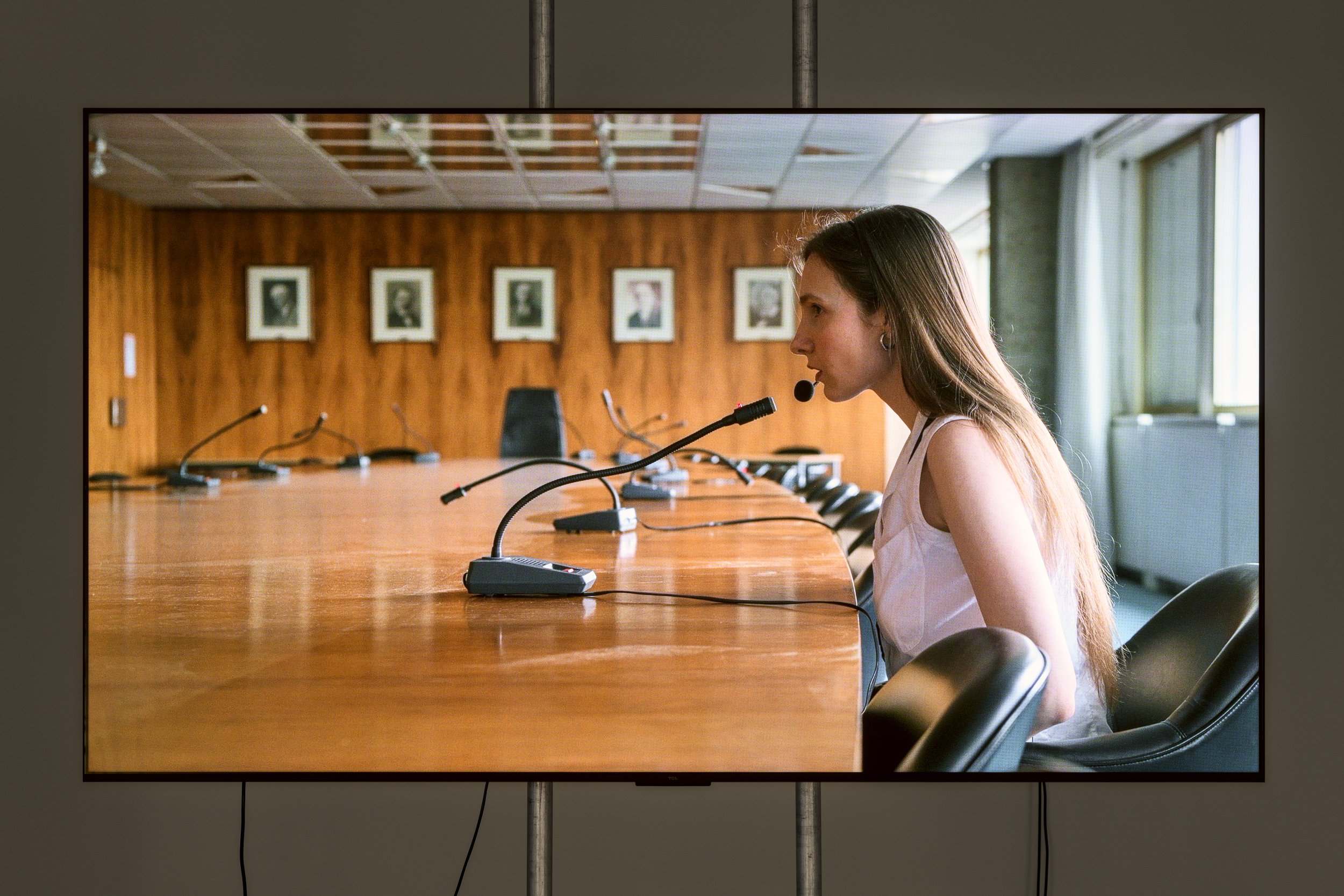
Drip Drip Point Warp Spin Buckle Rot, Daria Blum. Image credit Julian Blum.
Can you give us a brief introduction to the themes and ideas around your upcoming show at Claridge’s ArtSpace, Drip Drip Point Warp Spin Buckle Rot?
The work builds on my ongoing research into muscle memory, institutional power and degradation as they relate to dance, architecture, and intergenerational female relationships. The show is conceived around a three-channel video piece which follows a fictional character through deserted rooms and corridors of a declining 1970’s office building where she comes across a series of choreographies that she reenacts, together with gestures she has picked up from various sources. The sculptures in the show reference an absence of the voice, which was important to me during the making of this show. The live performance focuses on the simple gesture of the pointed finger — as a tool to claim or deflect attention — and unravels the character of the ‘performer’ to some degree.
Where does the title of the exhibition come from?
Working on the show, I had recently experienced a flood at my apartment, and my mind was filled with ideas about water leakages and drips, a home being invaded or falling apart, things related to loss, but also new beginnings. I often thematise architectural maintenance and decay in relation to interpersonal relationships and needs. Subtitles in the video piece describe the personification of this chronic jaw pain/headache as a female character who enters and disrupts the privacy of the home.
How do you see your practice developing in the near future? What would be your dream project?
I’d like to work on another EP or album in the near future.
Daria Blum: Drip Drip Point Warp Spin Buckle Rot runs at Claridge’s ArtSpace, Brooks Mews, until 25 October 2024. Performances will take place on 11 October and 17 October, both at 7:15pm. RSVP essential: artspace@claridges.co.uk.
For more information visit claridges.co.uk.
Peter Bellerby is the founder of Bellerby & Co. Globemakers, a company renowned for its exquisite hand-crafted globes. Established in 2010, the company specialises in meticulously designed pieces that showcase exceptional craftsmanship, positioning Bellerby & Co. as a leader in the globe-making industry…
Gabriele Beveridge is known for her sculptural and conceptual practice that combines materials as diverse as hand-blown glass, photo chemicals, and found images…
Robyn Orlin is a South African dancer and choreographer born in Johannesburg. Nicknamed in South Africa "a permanent irritation", she is well known for reflecting the difficult and complex realities in her country. Robyn integrates different media into her work (text, video, plastic arts) to she investigates a certain theatrical reality which has enabled her to find her unique choreographic vocabulary…
Katrina Palmer, an artist known for exploring materiality, absence, and dislocation, recently spoke to us following her year-long residency at the National Gallery about her exhibition The Touch Report…
Enej Gala is an artist who splits his time primarily between London and his hometown of Nova Gorica, Slovenia. A graduate of the Academy of Fine Arts in Venice and the Royal Academy Schools (2023), Gala first gained our attention with Neighbour’s Harvest, an installation that cleverly combined puppetry and conceptual art…
David Ottone is a Founding Member of Award-winning Spanish theatre company Yllana and has been the Artistic Director of the company since 1991. David has created and directed many theatrical productions which have been seen by more than two million spectators across 44 countries…
Darren Appiagyei is a London-based woodturner whose practice embraces the intrinsic beauty of wood, including its knots, cracks, bark, and grain. Highly inspired by Ghanaian wood carving, Darren explores raw textures and new woods in his work…
Huimin Zhang is an artist specialising in 22K gold, known for her innovative craftsmanship. She combines various cultural techniques, including filigree, engraving, and European gold and silver thread embroidery, to create unique works…
Akinola Davies Jr. is a BAFTA-nominated British-Nigerian filmmaker, artist, and storyteller whose work explores identity, community, and cultural heritage. Straddling both West Africa and the UK, his films examine the impact of colonial history while championing indigenous narratives. As part of the global diaspora, he seeks to highlight the often overlooked stories of Black life across these two worlds.
Hannah Drakeford is a London-based interior designer known for her bold and colourful interiors. She transitioned from a 21-year retail design career to interior design, and has gained popularity on social media where she now shares creative upcycling tutorials and encourages individuality in home decor…
Shula Carter is an East London-based creative with a background in contemporary, ballet, and modern dance. She trained at the Vestry School of Dance and later at LMA London, where she developed skills in commercial, hip hop, and tap dance, alongside stage and screen performance…
Dian Joy is a British-Nigerian interdisciplinary artist whose work delves into the intersections of identity, digital culture, and the fluid boundaries between truth and fiction. Her practice is rooted in examining how narratives evolve and shape perceptions, particularly in the digital age.
Dian Joy is a British-Nigerian interdisciplinary artist whose work delves into the intersections of identity, digital culture, and the fluid boundaries between truth and fiction. Her practice is rooted in examining how narratives evolve and shape perceptions, particularly in the digital age.
John-Paul Pryor is a prominent figure in London’s creative scene, known for his work as an arts writer, creative director, editor, and songwriter for the acclaimed art-rock band The Sirens of Titan…
Jim Murray is an actor, director, conservationist and artist known for Masters of Air (2024) and The Crown (2016). Murray first came to prominence as an artist in 2023 with his acclaimed inaugural exhibition In Flow, where his dynamic abstract paintings were hung in conversation with John Constable’s The Dark Sid…
Anthony Daley is an abstract expressionist painter known for his vibrant, large-scale works that explore beauty through intense colour and light. His art bridges the past and present, drawing inspiration from the Old Masters as well as diverse sources like literature, science, poetry, and nature.
Rachel Kneebone’s work explores the relationship between the body and states of being such as movement, stasis, and renewal. Through her porcelain sculptures, she examines transformation and metamorphosis, reflecting on what it means to inhabit the body and be alive…
Saff Williams is the Curatorial Director at Brookfield Properties, bringing over fifteen years of experience in the arts sector…
Sam Borkson and Arturo Sandoval III, the acclaimed LA-based artists behind the renowned collective "FriendsWithYou," are the creative minds behind "Little Cloud World," now on display in Covent Garden. During their recent visit to London, we had the privilege of speaking with them about their creative process and the inspiration behind this captivating project.
Kinnari Saraiya is a London-based Indian artist, curator, and researcher whose work focuses on trans-altern and post-humanist ideas from the Global South. She is currently a curator at Somerset House and has held positions at the Baltic Centre for Contemporary Art, Frieze Art Fair, and Bowes Museum....
Fusing her Asian roots with a fascination for African pattern work and her deep passion for architectural geometry, Halima’s work is intense yet playful, structured yet creative; substantial yet dynamic and invariably compelling in its originality.
Matilda Liu is an independent curator and collector based in London, with a collection focusing on Chinese contemporary art in conversation with international emerging artists. Having curated exhibitions for various contemporary art galleries and organisations, she is now launching her own curatorial initiative, Meeting Point Projects.
EKLEIDO, a choreographic duo formed by Hannah Ekholm and Faye Stoeser, choreograph performances for live shows and film.
Lydia Smith is one to watch. Currently on show in three different places across London, her work can be seen in a solo exhibition in the City, a group show in a chapel in Chelsea and through a new series of monumental sculptures installed outdoors across sprawling parkland…
Taipei-based IT entrepreneur Elsa Wang is the founder of Bluerider ART, a progressive gallery at the intersection of art and technology.
Jemma Powell is known for her observational landscapes. She is also an accomplished actress having featured in Tim Burton’s Alice in Wonderland…
Suzanna Petot, originally from New York, is a curator and writer based in London. She holds an MA in Curating the Art Museum from The Courtauld Institute of Art and has worked at various institutions in the U.S., Italy, and the UK, including Gallerie delle Prigioni, The Courtauld Gallery, Tate Modern, M.I.T List Center for Visual Art, and the Metropolitan Museum of Art…
Deep K Kailey boasts a highly successful career in the fashion industry, having made significant contributions to renowned publications such as Dazed, Vogue, and Tatler. However, driven by a quest for deeper meaning in life, she embarked on a transformative spiritual journey. This path ultimately led her to establish one-of-a-kind arts organisation Without Shape Without Form (WSWF)….
Elli Jason Foster and Millie Jason Foster are the dynamic co-directors behind Gillian Jason Gallery. This groundbreaking gallery is the first of its kind in the UK, wholly committed to celebrating female artists…
Megan Piper is the co-founder and Director of The Line, a public art project in east London, established in 2015. Prior to setting up The Line, she had a gallery in London’s Fitzrovia, where her exhibition programme focused on rediscovering and re-evaluating artists whose careers started in the 1960s and 70s…

What’s On in London This Week: Discover rooftop games at Roof East, cherry blossoms at the Horniman Gardens, and Easter fun at Hampton Court Palace. Plus, catch Loraine James live, Dear England at the National Theatre, and jazz nights at Ladbroke Hall…
London is set to showcase a rich and varied programme of art exhibitions this May. Here is our guide to the art exhibitions to watch out for in London in May…
With summer around the corner, what better way to spend a sunny day than by enjoying art, culture, and a bit of al fresco dining? Whether you’re looking for a peaceful spot to reflect on an exhibition or simply want to enjoy a light meal in the fresh air, here’s our guide to some of the best museum and gallery cafés with outdoor terraces in London….
As summer arrives in London, there’s no better time to embrace the city’s vibrant outdoor dining scene. Here is our guide to the best outdoor terraces to visit in London in 2025 for an unforgettable al fresco experience…
Wildlife Photographer of the Year 2025 · Gabriel Moses: Selah · Eileen Perrier: A Thousand Small Stories · Dianne Minnicucci: Belonging and Beyond · Linder: Danger Came Smiling · The Face Magazine: Culture Shift · Cecil Beaton’s Fashionable World · Deutsche Börse Photography Foundation Prize 2025 · Photo London 2025 · Taylor Wessing Photo Portrait Prize · Nature Study: Ecology and the Contemporary Photobook · Flowers – Flora in Contemporary Art & Cultur…
This April, Ladbroke Hall’s renowned Friday Jazz & Dinner series returns, showcasing an impressive roster of artists at its Sunbeam Theatre. Each evening pairs exceptional live jazz with a carefully crafted menu from the award-winning Pollini restaurant…
Holly Blakey: A Wound with Teeth & Phantom · Kit de Waal: The Best of Everything · Skatepark Mette Ingvartsen · Spring Plant Fair 2025 · Hampton Court Palace Tulip Festival 2025 · Loraine James – Three-Day Residency · Jan Lisiecki Plays Beethoven · Carmen at The Royal Opera House · Cartier Exhibition · The Carracci Cartoons: Myths in the Making · Nora Turato: pool7 · Amoako Boafo: I Do Not Come to You by Chance · Bill Albertini: Baroque-O-Vision Redux…
Robyn Orlin had her first encounter with the rickshaw drivers of Durban at the young age of five or six, an experience that left such a deep impression on her that she later sought to learn more about their fate. Rickshaws were first introduced to Durban in 1892…
Murder She Didn’t Write is misbehaviour live on stage peppered with self-awareness and unbelievably good writing. This isn't a fad, this isn't sloppy - it’s naughty and scathingly witty…
TOZI, derived from the affectionate Venetian slang for “a close-knit group of friends,” is the brainchild of an Italian trio that met while opening Shoreditch House under the Soho House Group. In 2013, Chef Maurilio Molteni, fresh from his time as Head Chef at Shoreditch House and developing the menu at Cecconi’s, opened the first TOZI restaurant in London…
Multitudes at Southbank Centre will reimagine live music through bold collaborations across dance, theatre, and visual arts…
Multitudes Festival · Ed Atkins, Tate Britain · Brick Lane Jazz Festival · Teatro La Plaza’s Hamlet · Holly Blakey: A Wound with Teeth & Phantom · Roof East · Hampton Court Palace Tulip Festival 2025 · London Marathon 2025 · ROOH – Within Her · Sultan Stevenson Presents El Roi · Carmen at The Royal Opera House · The Big Egg Hunt 2025 · Architecture on Stage: New Architects · The Friends of Holland Park Annual Art Exhibition 2025
Autumn 2025 will bring two exciting exhibitions to the Barbican: ‘Dirty Looks’, a bold fashion exhibition exploring imperfection and decay, and an innovative art installation by Lucy Raven in The Curve…
Robyn Orlin: We wear our wheels with pride · Architecture on Stage: Lütjens Padmanabhan · Jay Bernard: Joint · Black is the Color of My Voice · Joe Webb Trio · Rhodri Davies at Cafe OTO · Sunday Times Young Writer of the Year Award 2025 · Lyon Opera Ballet: Cunningham Forever · AVA London · Sister Midnight · Astonishing Things: The Drawings of Victor Hugo · Eunjo Lee · Arpita Singh: Remembering · Fiona Banner aka The Vanity Press: Disarm · Bunhead Bakery · Time & Talents
Looking for something truly special this Mother’s Day? There are a variety of unique gifts and experiences to take advantage of in London, whether your mother loves exploring world-class art galleries and museum exhibitions, wandering through historic homes filled with fascinating stories and remarkable collections, indulging in a luxurious spa treatment, or enjoying an unforgettable dining experience..
After 18 successful years at Edinburgh Fringe, The Big Bite Size Show arrives in London for the first time at The Pleasance Theatre, no less. A gem of a place for fringe theatre in London…
180 Studios will present the largest showcase of photographer and filmmaker Gabriel Moses’ work to date, featuring over 70 photographs and 10 films in March…
Cartier Exhibition at the V&A · Giuseppe Penone: Thoughts in the Roots · Antony Gormley: WITNESS · Richard Wright at Camden Art Centre · The Carracci Cartoons: Myths in the Making · Eileen Perrier: A Thousand Small Stories · Ed Atkins at Tate Britain · Richard Hunt: Linear Peregrination · Nolan Oswald Dennis at Gasworks · Nora Turato: pool7 · In House: Ree Bradley and Pete Gomes at Studio Voltaire…
The Shirley Sherwood Gallery of Botanical Art at Kew Gardens will showcase new botanical works, cinematic installations, and the connections between artists and trees…
Orchid Festival · Alice Sara Ott: John Field & Beethoven · Our Mighty Groove at Sadler’s Wells East · Seth Troxler at Fabric · North London Laughs – A Charity Comedy Night · London Symphony Orchestra: Half Six Fix – Walton · In Focus: Amir Naderi · Artist Talk: Citra Sasmita - Into Eternal Land · Noah Davis at Barbican · Theaster Gates: 1965: Malcolm in Winter: A Translation Exercise · Ai Weiwei: A New Chapter · Galli: So, So, So · Somaya Critchlow: The Chamber
The Cinnamon Club had completely flown under the radar for me. It is in a pocket of London I rarely visit, and even if I did, the building’s exterior gives little indication of what’s inside. But now that I’ve discovered it, I already have plans to return with my husband - and in my mind, a list of friends I would recommend it to…
An important exhibition has opened at the National Gallery co-organised with the Metropolitan Museum of Art. The Mayor of Siena, Nicoletta Fabio was in attendance on opening day to mark the exhibitions significance. Normally a major exhibition would take two to three years to come to fruition, in this instance, it has been in the making for eight year…
Máret Ánne Sara to create 2025 Hyundai Commission as Tate and Hyundai extend partnership to 2036.
Claudia Pagès Rabal: Five Defence Towers · Tirzah Garwood: Beyond Ravilious · Heather Agyepong: Through Motion · Christina Kimeze · Citra Sasmita: Into Eternal Land · Mire Lee: Open Wound · Linder: Danger Came Smiling · Galli: So, So, So · Mickalene Thomas: All About Love …
Marylebone Village to host a week of events championing female founders and entrepreneurs, including a panel discussion and fundraising for the Marylebone Project…
Battersea Power Station will host Good Fit, a month-long event featuring workouts, mindfulness sessions, expert talks, and wellness experiences…
Trisha Brown Dance Company & Noé Soulier – Working Title & In the Fall · (LA)HORDE / Ballet National de Marseille – Age of Content · Lyon Opera Ballet – Merce Cunningham Forever (BIPED and Beach Birds) · Neither Drums Nor Trumpets – Pam Tanowitz · Robyn Orlin – We Wear Our Wheels with Pride





